|
|
It's tragic how many
Armenians are so blinded by hatred that they prefer to live in the past, and
deny themselves the joys of their roots. Not all Armenians are like that. Some
Armenians prefer concentrating on their emotional attachments to the old
country. These Armenians know Turkish music, food and language form as much a
part of their identities as anything else, and don't appreciate being
ostracized by the larger, more hateful Armenian group. They feel they are
robbed of their precious past and cherished memories, and resent the
domineering attitude of the other group.
I'm a big fan of Edward
Tashji, who has the guts and the love to come right out and declare where
he stands. In his own words, this "Armenian-American has become 'famous,'
(he said with all humility), within the Turkish community, while becoming
"infamous", (he said with deep regret), within the Armenian
community." Also, in his words... he is : "An American born of an
Armenian mother and a Syrian-Orthodox father (.) He is the younger son of
parents who had been born in Ottoman Turkey, became eye-witness to the
conflagration of the First World War in their beloved homeland, and as a
result, their destiny brought them to the land where millions had
emigrated."
|
|
|
| An
Armenian Sponsored Lecture, and Turkish-Americans Were There! |
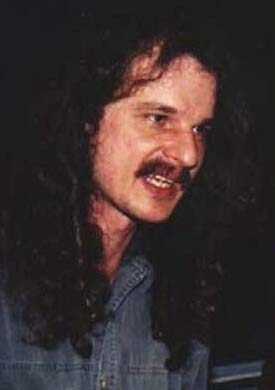 |
|
Hilmar
Kaiser... "Genocide Scholar" |
On the evening of January 29, 1999 — a lecture sponsored by the
New York Armenian Students Association and The Armenian Club of NYU- was presented in the
Loeb Student Center, at New York University, in New York City. The invited speaker was Mr.
Hilmar Kaiser, who is described as: “...a historian specializing in German-Ottoman
relations and the Armenian, (so-called) Genocide. He is currently working at the Armenian
Research Center, at the University of Michigan...“ The lecture was titled: “Ottoman
Elites and the Armenian, (so-called), Genocide”. No other speaker was in attendance, and
at the conclusion of the one hour lecture, questions were welcomed from the audience.
First, let us begin with a few specifics:
Based upon a visual estimate, the audience numbered about 75 people, which included about
35-40 persons representing the Turkish-American community. With the exception of my wife
and myself, our entire group was comprised of our young ladies and gentlemen, for whom the
Federation and our entire community owes a debt of gratitude and congratulations for their
magnificent behavior and intelligent questions submitted to the speaker. If I attempt to
mention names, I will certainly overlook many for whom I have the deepest affection and
profound respect. Among our organizations represented: students and young people from the
Young Turks Cultural Aid Society, the Intercollegiate Turkish Students Society, (ITSS),
other organizations as well as our Federation. (Our numbers were unexpected, and as a
result, the expressions of amazement on Armenian faces equaled the astonishment of the
speaker.
At the outset, the speaker urged the audience to keep an “open mind” and rather than
resort to emotional outbursts, an “intellectual” discourse would be more desirable.
|
|
From Mr. Kaiser‘s opening comments it became
evident that he was not about to adhere to his own suggestion for an impartial
discourse. Had he intended to be impartial, he would not have been invited by his
Armenian hosts. When an Armenian questioner had referred to him as “professor”,
Mr. Kaiser responded that he was not a professor; not that that would have made a
difference since many pseudo-intellectuals are motivated by their own personal
agenda. His lengthy speech described his view that Germany had conspired with
Ottoman authorities to annihilate the Armenian people. It appeared he had traveled
extensively throughout Turkey, gathering information for his “research”. He made
a poor attempt at naming in Turkish Ottoman cities and officials. With
terms such as, “Turkish criminals”, “Turkish crimes against children”, and
Turks described as, “pathological rapists”, any semblance of an “intellectual”
discourse became non-existent! His tirade continued to the pleasure of the
Armenians; and though he was an ethnic German, he was very critical of the Germans
during the First World War. He had not anticipated our Turkish youth, and as a
result many of his responses were ineffectual. His poor attire and shoulder length
hair had to be a disappointment, to his Armenian hosts.
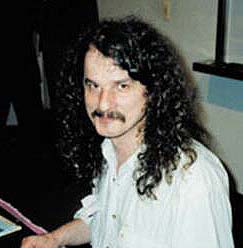 |
|
Mr.
Kaiser |
In response to many questions from both groups,
Mr. Kaiser would reply: “That was not an area of my research!” His “research”
revolved around 1915 but NOT 1890 or any other period pertinent to Turkish-Armenian
history. I was amazed when he referred to the “Dashnaksagan” group, but he “forgot”
to mention it was the murderous revolutionary entity established in 1890! Could it
be he felt the Armenian revolution was not significant??! Toward the end of the
lecture, a young man from our group stood up and said: “I am a member of the Young
Turks," and while he proceeded to ask his question, the speaker became very
alarmed, since he had spoken about “The Young Turks Movement” during the Ottoman
period. Another of our youth shouted to Mr. Kaiser: “He is the reincarnation of
the Young Turks!” On both sides of the room there followed uproarious laughter!
|
| ...What
was most interesting was not what (the speaker) said, but what he DID NOT say! |
Very early in the lecture I had asked a question, and after the
moderator would not allow me to speak further, voices from our group demanded: “Let him
speak! Let him speak!” The speaker and every Armenian in the room were on the verge of
shocking disbelief when in a clear and audible voice, I had revealed my Armenian-Syrian
Orthodox background. Just before the lecture was closed, one of our young men stood up and
resolutely requested I be allowed to make a final comment. Mr. Kaiser must have been
intrigued — to say the least — by this Armenian who with his Armenian wife was seated
among these “reincarnated” Young Turks. Though one minute was requested, our generous
speaker granted me two minutes. I referred to a so-called Talat Pasha telegram which had
been fraudulently published by Aram Andonian. On the forged “document” Andonian had
written at the top of the page the word: “Bismillah”. I revealed that no official
Ottoman document had this word printed on it. The speaker looking at me intently, nodded
his head affirmatively. When I added that the forger Andonian had dated the fake telegram
according to the Gregorian calendar instead of the Moslem calendar, the “learned”
speaker while nodding his head affirmatively, added: “He was off by thirteen days!” I
made comments about the following names: Mark Bristol, Yarrow, and Barton. With each
comment the speaker continued to nod his head. He knew well of what I was speaking, and
what was most interesting was not what he said, but what he DID NOT say!
While looking at the Armenian audience, I concluded: “For how long will these young
people suffer the consequences of ancient hatred?! It is enough already, it is enough!”
An applause
was heard from our side. Two items need to be
briefly referred to: An elderly Armenian lady and a young Armenian girl approached me with
favorable comments. The second, my wife told Mr. Kaiser: You broke the rules that's why
you were removed from the Ottoman archives! With my deep appreciation to our beloved young
people, I say: Our work continues!!
The above is a report (dated February 3,
1999) from the Federation of Turkish American Associations
ADDENDUM:
A visitor who was at this very event sent the following pictures; thank you.
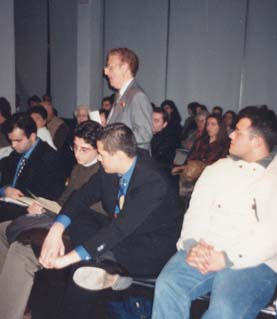
Edward Tashji addresses Mr. Kaiser, from
the audience; Mr. Kaiser is seen below,
sitting behind the table.
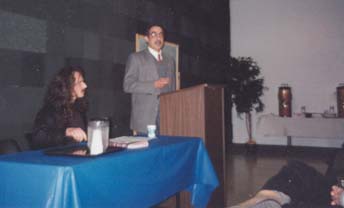
|
Holdwater Comments:
|
|
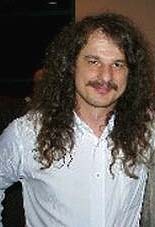
|
|
Is
Hilmar Kaiser the
reincarnation of Johannes
Lepsius, in terms of German-
Turkish friendship? |
I recently read Mr.
Kaiser photocopied some 3,000 records from the Ottoman archives. I don't know what
rules he might have broken, but it is possible people with an agenda can do
unethical things to documents not in support of their cause. Those like Kaiser and Ara Sarafian complain they were kicked out of
the archives... implying the authorities were worried that they would discover
something and would prefer to "cover up"... however, it's important to
keep in mind that these partial people... whose primary purpose is to sling mud...
were allowed in the archives in the first place. You can read more about the ins and
outs in Ottoman
Archives are Fully open.
Here is what Arpik Paraghamian
wrote of the subjective genocide scholar, in an article from an Armenian site
entitled, "Hilmar Kaiser Raises New Legal Issues Through Study of Armenian
Genocide":
Stolen property and reparations to the
survivors and descendants of those martyred during the Armenian Genocide of 1915 was
the focus of a lecture by Hilmar Kaiser during his fourth visit to Fresno State on
November 6, 2000.
Kaiser, a doctoral candidate at the European University Institute in Florence,
Italy, spent four years studying Turkish archives on this topic. Kaiser said he
tried to collect all the information he possibly could before he was kicked out for
his persistent visits in 1995.
Kaiser found not only proof that the Ottoman government had planned, organized and
monitored the deaths of 1.5 to 2 million Armenians in 1915 and specified
instructions on their deportation, but also that the Turks had settled Muslims onto
Armenian property, without allowing Armenians to sell their land.
Wow. So he actually found
PROOF. Sounds pretty ground-breaking. This is the golden fleece pro-Armenian
genocide enthusiasts have been enthusiastically seeking. I wonder... what this proof
can be?
If this fellow spent all that
time in the Ottoman archives, why would he deliberately avoid all the
counter-evidence he surely must have come across? What would motivate such
dishonesty?
He gets a job at Dennis
Papazian's Michigan-Dearborn university, the Armenian-loving institution that gave
another pseudo-scholar, Taner Akcam, his first break. Meanwhile, Kaiser goes around
giving these Armenian "Genocide" talks, making a name for himself.
Interesting.
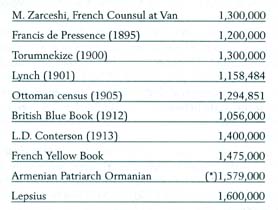 |
|
Estimates
of the Ottoman-Armenian population |
Meanwhile, he displays his
scholarly worth by declaring 1.5 million to 2 million Armenians died, which would
have meant a negative number of Armenians would have survived, based on
"impartial" pre-war population estimates, rarely exceeding 1.6 million as
the total number... especially since Armenians concede one million Ottoman-Armenians
survived. In order for Hilmar Kaiser's curious conclusion to be true, 2.5 million to
3 million Armenians would have had to be living in the Ottoman Empire. 3 million was
the worldwide estimate, and there were already over a million living in Russia...
before the war broke out.
In another article (from
Arakel Arisian) entitled, "Adana Massacre Topic of Kaiser Talk in
Fresno," we learn more:
One such tragedy which has gone unnoticed is the Adana Massacre of 1909, which was
the murder of 25,000 to 30,000 Armenians and a precursor to the Armenian Genocide of
1915 where 1.5 million were killed. Hilmar Kaiser, a scholar-in-residence at the
University of Michigan-Dearborn, is an authority on the Adana Massacre of 1909.
This is the area where I
first learned of Mr. Kaiser... he is supposed to be an expert regarding the Adana
period. From the rest of this particular article, it sounds like the Armenians were
helpless victims... and there is no mention that the rebelling Armenians "fired
the first shot," as they did in 1915. the dishonesty is appalling. A
preliminary look at the Adana period may be found in my analysis of Peter Balakian's
book, "The Burning Tigris": Adana.
According to "The Armenian
File": The Patriarchate gives the number of dead as
21,300 based on the investigation it carried out. The Edirne representative,
Babikian Efendi, had prepared a report to be submitted to the Assembly. He gave the
number of dead as 21,001. Note these numbers are from Armenian sources of the
period, both likely exaggerated. Who is coming up with the 25,000-30,000 figures?
Since the article is based on Hilmar Kaiser, I suppose it would be safe to assume
these are figures Mr. Kaiser supports. Why would Kaiser offer ridiculously high
figures not even supported by Armenian sources of the period?
Dr. Dickran Kouymjian, Director of the Armenian Studies Program, commented in his
introduction, " What makes Hilmar Kaiser's work so very important is that he is
passionately involved in the material and he has a very strong moral sense."
Yep. One-sidedly offering false
history is the very essence of morality, all right.
|
| |
|
|